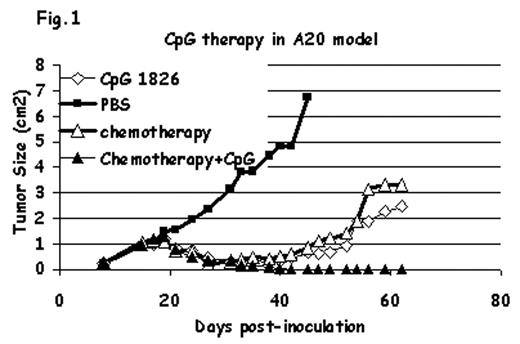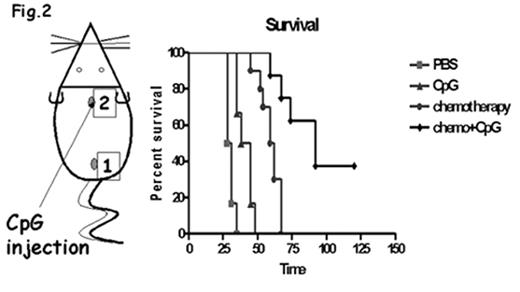Abstract
CpG is an immune stimulator that can activate both innate and adaptive immunity. By binding to its receptor, TLR9, CpG can activate dendritic cells and B cells by inducing the secretion of cytokines, and increasing the expression of costimulatory molecules, such as CD80 and CD86. In this study, CpG1826, a B type CpG was given intratumorally to BALB/c mice bearing a A20 transplantable B cell lymphoma as a s.c local tumor with accompanying metastatic disease. In this model, CpG alone delayed the growth of tumor, however, the majority of the treated tumor-bearing mice still died. We therefore tested a new therapeutic strategy, a combination of cyclophosphomide (CTX), followed by subsequent intratumoral injection of CpG. The rationale for this strategy is that the danger signals generated by chemotherapy attract the migration of immature DC to the tumor site, and these DCs are activated by subsequent injection of CpG. Our animal studies showed that the combined maneuver can completely regress well-established tumor (Fig.1). The combination of CTX with CpG could cure well-established large size (>1.2cm in diameter) tumors, and the mice remained tumor-free for 5-6 months after the initial treatment. Conversely, the majority of mice that received CTX or CpG alone died of lymphoma. We also showed that this combined effect was CpG injection site dependent, as CTX combined with intratumoral injection of CpG had a much better therapeutic effect (100% survival), as compared to injection of CpG into a distant normal site (20% survival). Our studies also indicated that this combined effect is CD8+T cell dependent, as systemic effects were lost when we repeated this experiment in a CD8+ T cell knockout mouse model. We also showed that CD4+ T-cells and B cells are not required in this system by depleting CD4+ T cells and by using a B cell knockout mouse model. Most importantly, we demonstrated the systemic effect of this combination strategy in mice bearing tumors at two different sites. As shown in Fig. 2, in combination with CTX, injection of one site with CpG controlled the growth of the second site tumor as opposed to a transient anti-tumor effect from chemotherapy or CpG alone. The systemic effect induced by injecting a single tumor site led to significant prolongation of overall survival (p<0.01). In summary, this combined chemoimmunetherapeutic strategy has showed both local and systemic anti-tumor effects, which may be a potent anti-tumor strategy in the clinic.
Author notes
Corresponding author



